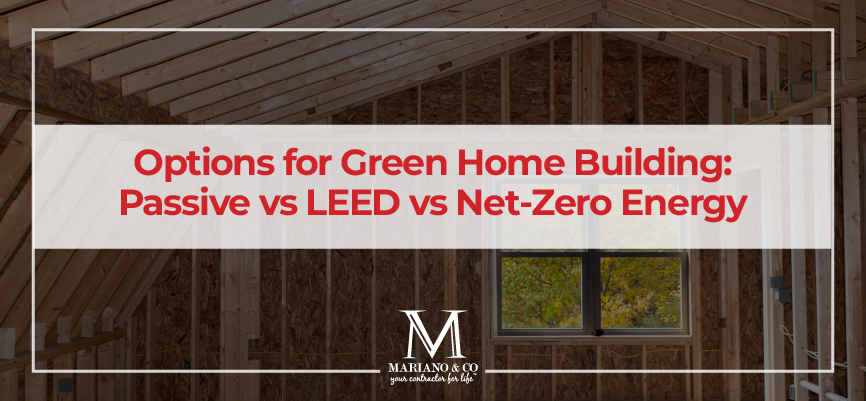
Over 2 million green homes are registered or certified worldwide, and more homeowners are recognizing the benefits of energy-efficient living.
But when you’re building a green home, how do you choose between Passive vs LEED vs Net-Zero Energy?
For Arizona homeowners, choosing the right sustainable building method is about creating a comfortable, eco-friendly home that works with our intense climate.
Whether you’re drawn to the cutting-edge tech of Net-Zero Energy homes, the rigorous standards of LEED certification, or the natural efficiency of Passive House design, the stakes are high.
Understanding these options can change the way you live, save you money, and make your home a true sanctuary.
Ready to explore the right green home-building approach for you? Keep reading to learn more.
What is Passive House Design?
Passive House design is built on the principle of using minimal energy for heating and cooling.
This approach relies heavily on:
- Airtight construction
- Superior insulation
- Taking advantage of passive solar gain (natural heat from the sun)
In a climate like Greater Phoenix, where summer temperatures regularly soar above 100°F, Passive House techniques can dramatically reduce the need for air conditioning.
By ensuring that homes remain well-insulated and sealed, homeowners can maintain a comfortable indoor climate without relying on high-energy cooling systems.
One of the standout benefits of Passive House design is its potential to lower energy bills significantly.
Since these homes are built with extreme energy efficiency in mind, they require little to no heating and cooling even in extreme weather conditions.
For example, according to the Passive House Institute, homes built using this method can reduce energy consumption by up to 90% compared to traditional homes.
This makes Passive House particularly attractive for residents of Phoenix and surrounding areas, where high energy costs are common due to heavy air conditioner use in summer.
However, the upfront costs for Passive House construction can be higher than standard builds.
The materials required, like specialized insulation and high-performance windows, are often more expensive.
What is LEED Certification?
LEED, or Leadership in Energy and Environmental Design, is a globally recognized certification system for green architecture.
It was developed by the U.S. Green Building Council (USGBC) and focuses on promoting sustainability across various areas of construction, including:
- Energy efficiency
- Water use
- Materials sourcing
LEED operates on a points system, with homes earning points for sustainable building methods, such as using eco-friendly home design elements, sustainable materials, and energy-efficient technologies.
The certification can range from basic LEED certification to higher levels such as Silver, Gold, or Platinum, depending on how many points the project earns.
One of the main advantages of LEED-certified homes is their flexibility.
While the standard is rigorous, builders have various pathways to meet the criteria.
For instance, a home might earn points for using recycled materials or installing water-efficient plumbing systems; both of which are important in water-scarce areas like Phoenix.
LEED certification also emphasizes indoor environmental quality, which includes ensuring good air quality and using non-toxic building materials.
These are especially important factors for families concerned about health and wellness.
On the downside, LEED certification can sometimes be more costly than other sustainable construction techniques.
Homes built to LEED standards may not always achieve the same energy efficiency levels as Passive or Net-Zero homes, depending on the specific design and materials used.
What is Net-Zero Energy Building?
A Net-Zero Energy home is designed to produce as much energy as it consumes over a year.
These homes combine highly energy-efficient design with renewable energy sources, most commonly solar panels, which are particularly effective in sunny regions like Phoenix.
The goal of Net-Zero construction is to reduce the home’s energy demands through airtight construction, insulation, and energy-efficient appliances while meeting the remaining energy needs with renewable energy.
In Phoenix, where sunshine is abundant for most of the year, Net-Zero Energy homes have a distinct advantage.
Solar energy can be a reliable and cost-effective solution for reducing dependency on traditional energy sources, which can lead to significant long-term savings on energy bills.
The U.S. Department of Energy notes that Net-Zero Energy homes can save homeowners thousands of dollars over the lifespan of the home by generating their own energy, which is particularly valuable in areas with high utility rates like Arizona.
The major downside of Net-Zero Energy homes is the upfront investment.
Solar panels, energy-efficient windows, and high-quality insulation all come with a steep price tag.
Additionally, the systems required to store and manage the home’s energy production, such as battery storage for solar energy, can add to the cost.
Passive vs LEED vs Net-Zero Energy: Key Considerations
When deciding between Passive, LEED, and Net-Zero Energy homes, there are several key factors to consider.
First, think about the climate in your region.
In Greater Phoenix, where temperatures are extreme, energy efficiency should be a top priority.
Both Passive and Net-Zero homes offer significant benefits in terms of reducing energy use in hot climates, as they rely on airtight construction, high insulation, and energy-efficient homes designed to stay cool without excessive air conditioning.
Cost is another critical factor. While LEED certification provides a broad approach to green architecture, it may not always be the most energy-efficient or cost-effective solution, depending on the specific project.
LEED homes can be more expensive due to the wide range of sustainable building methods they incorporate, from water conservation to using eco-friendly materials.
However, they are flexible and offer a comprehensive approach to sustainability, which appeals to many homeowners.
For those whose primary goal is minimizing energy consumption and cutting utility bills, Passive or Net-Zero Energy homes may be the better choice.
Passive homes can offer the lowest ongoing energy costs, while Net-Zero homes provide the added benefit of energy independence through solar power.
Your Path to an Energy-Efficient Future
Choosing between Passive vs LEED vs Net-Zero Energy comes down to understanding your priorities for sustainability and energy savings.
While all three approaches help create energy-efficient homes, each has unique benefits that cater to different goals.
At Mariano & Co., we pride ourselves on being more than just builders.
With our 5 STAR Experience, we ensure that your green home is crafted with precision, high-quality materials, and a focus on detail that other contractors simply can’t match.
Contact us today for a free estimate and take the next step toward your sustainable future.
Looking for a Home Building Contractor in Phoenix?
Choose Mariano & Co. for top-tier general contracting services. Specializing in luxury remodeling and high-end home construction, we are dedicated to delivering a 5-star experience.
Call (480) 287-4096 or request an estimate online today!

